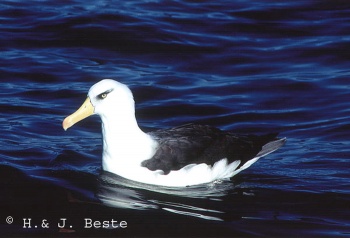Alternative name: Black-browed Mollymawk
- Thalassarche melanophris
Identification
Length 79–93 cm (31-36¾ in). Wingspan 240cm.
- Adult: back greyish-black, palest on mantle, upperwing brownish-black with pale primary shafts, rump white, tail grey. Head white with dark eyebrow, underparts white. Underwing has black tip, black trailing edge, narrowest on innerwing and broad black leading edge forming a dark wedge midway along inner wing. Iris brown, bill yellow to bright orange with narrow black line at base, legs bluish-white.
- Immature: juvenile as adult but has grey nape and breast-band and variable underwing usually a duller version of adult. Bill horn-coloured or grey with dark culmen and tip. Subadult has whiter head and fainter breast-band, bill dull yellow with dark tip and underwing more like adult.
Similar Species
Adult distinguished from Grey-headed Albatross by yellow bill, whiter head with dark eyebrow, and broader dark leading edge to underwing and from both Indian Yellow-nosed Albatross and Atlantic Yellow-nosed Albatross by yellow bill and underwing pattern.
Distribution
The most numerous, widespread and most-frequently encountered albatross.
Circumpolar in Southern Oceans. Breeds on Cape Horn and Staten Island, the Falkland Islands, South Georgia, Kerguelen, Heard, Antipodes, Macquarie and Campbell Islands. Post-breeding dispersal throughout Southern Oceans mainly between 65 and 23 degrees south but range extends to about 10 degrees south off Peru and 20 degrees south off Africa.
Vagrancy

Photo © by Hans&Judy Beste
Wollongong, New South Wales, Australia, July 2002
Does not occur in the North Pacific but annually recorded in the North Atlantic north to Iceland and the Faroes, northern Norway and even Svalbard. Most are recorded off the south-west British Isles but also recorded in the Mediterranean off Corsica. While most are seen at sea some individuals have returned to the same gannetry each summer for successive years, a recent one returning to Unst in Shetland, Scotland almost every year from 1969 until 1996.
Taxonomy
Diomedea vs. Thalassarche
Genera Phoebastria and Thalassarche formerly placed in the Diomedea, but now considered by virtually all authorities (Clements, Howard & Moore, AOU, BOU, SACC) to be separate genera in light of Nunn et al. (1996) and Penhallurick & Wink (2004).
melanophrys vs. melanophris
Using melanophrys, Howard & Moore (2003) seems to be the only authority upholding this variant spelling (Clements, Sibley & Monroe, AOU, and BOU all use melanophris). The SACC currently uses melanophrys, though it is listed with the caveat that a proposal is needed to sort out melanophrys vs. melanophris.
Subspecies
Two subspecies recognised[1], separable at sea.
- T.m. melanophris:
- Occurs over most of range
- T. m. impavida: Differs from nominate in honey-coloured eye, more extensive eyebrow and more extensive dark underwing with grey rather than white axillaries, more extensive dark inner coverts and broader dark leading edge.
- New Zealand sector breeding on the Campbell Islands alongside a few of the nominate race, and perhaps also the Antipodes Islands.
BirdLife International (2008) recognise Campbell Albatross as a separate species (T. impavida), citing Robertson and Nunn (1998) and Brooke (2004); they classify it as Vulnerable in the 2008 IUCN Red List.
Habitat
Colonial breeder on grassy clifftops on islands, otherwise at sea and regularly follows ships.
Behaviour
Breeding
Breeds September-early May, nest is a large bowl made of mud, vegetable matter and feathers. One egg, white with red-brown blotches at larger end (103 x 66mm). Incubated by female for 56- 70 days and young fed by both parents. Fledges after about 5 months.
Diet
Squid, cuttlefish, crustaceans and fish, sometimes refuse from ships.
Vocalisation
Loud and plaintive sheep-like cry at nest, grunting, coughing and cackling calls when competing for food at sea.
References
- Clements, J. F., P. C. Rasmussen, T. S. Schulenberg, M. J. Iliff, T. A. Fredericks, J. A. Gerbracht, D. Lepage, A. Spencer, S. M. Billerman, B. L. Sullivan, and C. L. Wood. 2023. The eBird/Clements checklist of Birds of the World: v2023. Downloaded from https://www.birds.cornell.edu/clementschecklist/download/
- BirdLife International (2008) The BirdLife checklist of the birds of the world, with conservation status and taxonomic sources. Version 1. Downloaded from http://www.birdlife.org/datazone/spe..._Version_1.zip [.xls zipped 1 MB]. For more details, see: http://www.birdlife.org/datazone/species/taxonomy.html
- Brooke, M.de L. (2004) Albatrosses and petrels across the world. Oxford: Oxford University Press.
- Robertson, C.J.R. and Nunn, G.B. (1998) Towards a new taxonomy for albatrosses. Pp. 13-19 in Robertson, G. and Gales, R., eds. Albatross biology and conservation. Chipping Norton, Australia: Surrey Beatty & Sons.
Recommended Citation
- BirdForum Opus contributors. (2025) Black-browed Albatross. In: BirdForum, the forum for wild birds and birding. Retrieved 13 January 2025 from https://www.birdforum.net/opus/Black-browed_Albatross
External Links
GSearch checked for 2020 platform.1






